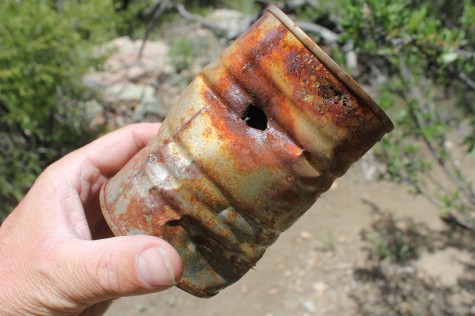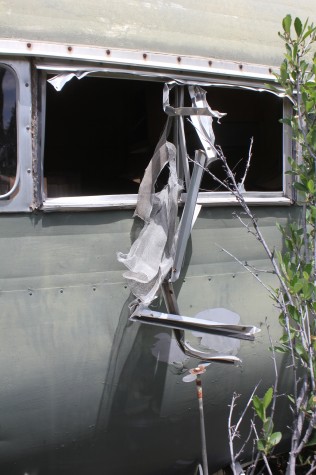A bear broke into my wife’s old teardrop trailer in the foothills of the Sangre de Cristo Mountains in southern Colorado. It must have been yearling by the bite marks in bean cans, and the smallness of its hips where it busted out the door-window and dragged itself inside. The bear didn’t find much, leaving by the front window, aluminum frame ripped to tatters.
I studied where it had pawed into a cabinet, tearing off a door, crashing through the one and only shelf, revealing where it had stood, snout flexing to smell for anything good, paws smudging the small refrigerator, unable to free the latches or hinges, giving up, probably disappointed. Tracking its moves through the trailer, what it destroyed, what it did not, I felt as if I were seeing a secret part of its life, a glimpse into the day of a bear.
Perhaps it learned from its mother that trailers alone in the woods are often unguarded and can come with a store of food. Around the Sangre de Cristos, bears are known to open trailers like tuna cans. This one didn’t get so much, probably not worth the effort, if you can imagine a black bear using is practically prehensile lips to suck refried beans out of a can punctured by a single canine tooth, an egress the size of a .22 bullet hole.
As a yearling, it would have been around 18 months old, the time a black bear leaves its mother and begins foraging entirely on its own, perhaps this trailer being its first hit.

Where was it now, off pillaging other campers? Now entering its second summer, the bear was probably 50 pounds heavier than when it did this damage, too big anymore to fit through a flimsy door-window. If it were a female, it might still be in the area, having found a niche for itself in the invisible territories and social order of bears. If male, chances of it remaining in the neighborhood are slimmer, better chance it was traveling wider ranges.
The behavioral gender difference in most animals is often so statistically slight that researchers are beginning to cut gender from migration models. But black bears do tend to have a bias, average range of a female topping out around 10-15 square miles, males 40-60 depending on terrain, crowding and resources. A mature male’s home range will often overlap with home ranges of several female bears.
In this trailer, the bear’s story was secondary to what it let in. Its passage allowed entry for a woodrat who had been shitting an impressive nest for itself since last fall. This was a more intimate view into the life of an animal. Woodrats, same thing as packrats, genus Neotoma, are collectors, nest-builders, and this one had gone to town, bringing in every small shiny, pokey thing it deemed worthy, and it had been doing this for months.
Woodrats create a substance known as amberat where sugar in the urine crystallizes as it dries, forming a cement that sometimes takes a metal chisel to break off, or plenty of hydrogen peroxide that sometimes reduces it to a sticky tar. This amberat basically fossilizes whatever it covers, cementing a nest into place, a nest that will do nothing but grow over time. This why woodrat middens produce some of the best dated palebotanical data around the world. Researchers have cored these middens, picking up pollens and leaves frozen in time and layered atop each other allowing for dating. The oldest radiocarbon-dated woodrat middens go back 50,000 years, and these were still occupied when researchers dug into them.
The woodrat in the trailer had left different ages of amberat, from an older hard, black substance to sticky amber-colored deposits the consistency of honey. The rodent showed an almost methodical approach to its conquering of the trailer. It would work on an area for a while by urinating there, then move to another spot. Its plan, inasmuch as a woodrat might have a plan, may have been to start a process that would ultimately take tens of thousands of years and countless woodrat generations, each one living to about 10 years, to finally fill this trailer to the ceiling with baubles and rodent guano and amberat.
Dressed ridiculously in a shower cap, dust mask and latex gloves last week, with a chisel and bottles of hydrogen peroxide, I went in to stop the process. Banging and scrubbing to get the place back into shape, I was a few hours into the task when I opened a drawer to find the woodrat motionless in a nest of shredded yellow pages. With ears adorably large and concerned-looking eyes as black as obsidian, it did not move at first. Night-forager, rock-dweller, it seemed to be in a state of shock. This drawer must have seemed, to the woodrat, the most protected chamber of its warren, which was the entire inside of the trailer.  I had cleaning to do, little time for sentiment, and I rattled the drawer to get the woodrat moving. It jumped away, and had some trouble navigating what was obviously a changed environment where I’d thrown out cushions and blankets that it had ruined. It leapt up to the hole the bear had left on its way out and paused there, balanced in the wreckage of the front window, the place it obviously knew to come in and out. Just for a second, it glanced back, perhaps stricken by what I’d done to the place, all of its careful work destroyed. Either that, or it wasn’t quite awake, shaking off a bad dream before bounding out the hole into daylight and the rest of its life.
I had cleaning to do, little time for sentiment, and I rattled the drawer to get the woodrat moving. It jumped away, and had some trouble navigating what was obviously a changed environment where I’d thrown out cushions and blankets that it had ruined. It leapt up to the hole the bear had left on its way out and paused there, balanced in the wreckage of the front window, the place it obviously knew to come in and out. Just for a second, it glanced back, perhaps stricken by what I’d done to the place, all of its careful work destroyed. Either that, or it wasn’t quite awake, shaking off a bad dream before bounding out the hole into daylight and the rest of its life.

It shows the effect of a good read that I cannot hear or read of bears any more without thinking of Rafi Zabor’s bear, a bear who talks bop and plays alto sax, a Bear who channels Bird. I’m afraid I would have been looking for dropped reeds.